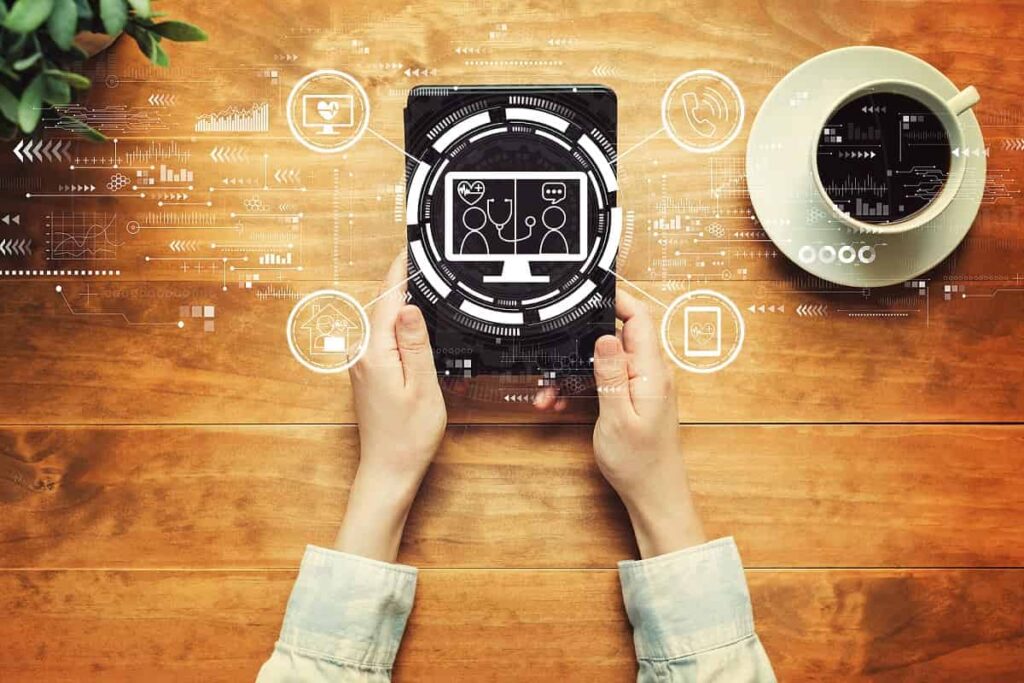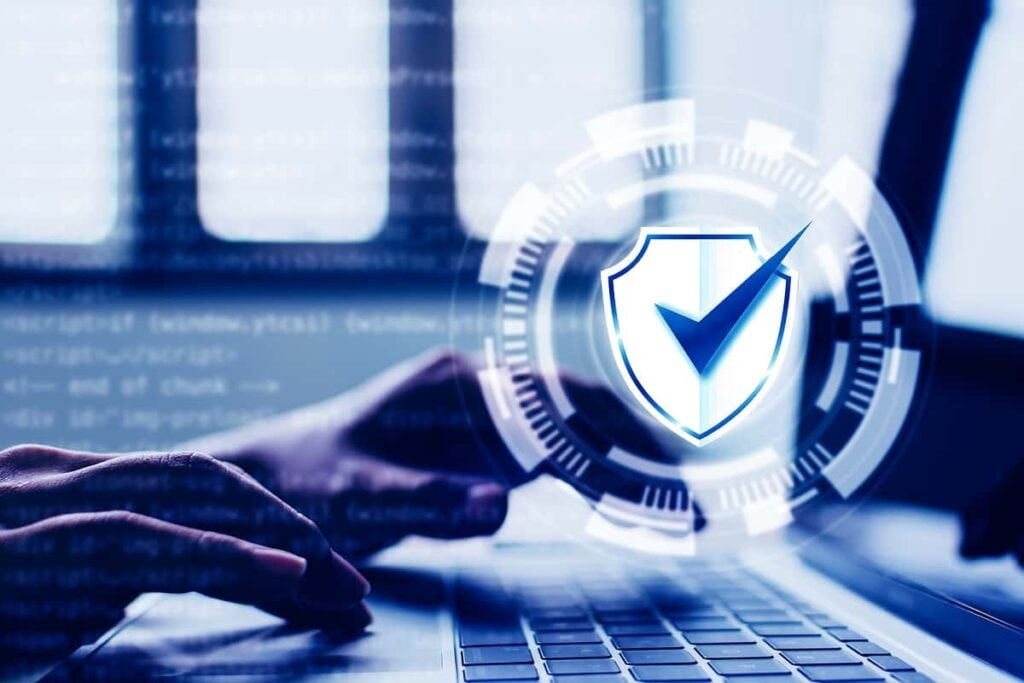8 Telemedicine Startups to Watch – Half Use AI
Table of contents

Every year the U.S. spends $2.9 trillion in healthcare and you can rest assured that technology startups are gunning for a piece of that spend. As chatbots become better at sounding like humans, and with artificial intelligence (AI) medical imaging algorithms now performing at a level better than humans, it’s only a matter of time before we start seeing the automation of healthcare. One form this takes is referred to as “telemedicine” which is defined differently from telehealth or telecare as follows:
- Telehealth – Broad definition applied to providing health education, health services, prescriptions, etc. remotely
- Telemedicine – Remote diagnosis and evaluation of patients
- Telecare – Moving healthcare into the home to enable independent living
Back in the 1950’s, telemedicine was used to diagnose and treat patients who lived and worked remotely or who had minimal resources by means of telecommunications technology. Fast forward 50 years or so and now everyone is constantly connected to the internet via their smartphones and more importantly, they are comfortable engaging with and trusting technology.
Since we last looked at publicly traded telemedicine provider Teladoc (NYSE:TDOC), quite a few startups have been making advances in telemedicine, many of which are using AI. Here’s a look at 8 startups involved in the development of telemedicine which plan to dramatically reduce the average 18.5 days most people wait to see a doctor these days.
American Well
Founded in 2006, Boston startup American Well has taken in $141 million in funding so far to develop a telemedicine service that can be used by employers, health plans, or the government. The system is “software-as-a-service” or SaaS which means as a firm, you can easily integrate the platform within your own brand. There is also a “direct to consumer” offering called Amwell. With 96% of U.S. states allowing online doctor visits with prescription, the 60% of Americans who take prescription drugs should have a much easier time
self medicating getting treatment. Here are the price points if you’re interested:
Just last month, American Well partnered with Samsung so it looks like soon you won’t even need to download the app since it will now be a part of the “Samsung Health” service.
Update 05/21/2020: American Well has raised $194 million in Series C funding to help keep up with the skyrocketing demand for telemedicine. This brings the company’s total funding to $711 million to date.
Babylon
Founded in 2013, London based startup Babylon has taken in a total funding of $85 million so far with $60 million of that total being raised just last month. If that name sounds familiar it’s because we just highlighted them in an article titled “Is Babylon’s AI Chatbot the Future of Healthcare?”
Babylon’s stated ambition is to offer anyone throughout the world who has a smartphone access to quality healthcare services. Of course, they aren’t operating as non-profit, so in order to actually engage with a healthcare provider, you’ll need to pay some British pounds. We say pounds because up until now, Babylon paid services are only available to British residents (there is an option for Ireland residents too).
The recent funding will be used to scale Babylon’s AI-powered clinical diagnosis capabilities. Through Babylon’s smartphone app, you are able to access a consultation with a doctor anytime, describe your symptoms and be given an accurate diagnosis all while machine learning works quietly behind the scenes, taking notes and analyzing millions of combinations of symptoms without delay.
Update 08/02/2019: Babylon Health has raised $550 million to maximize its mission to put accessible and affordable healthcare into the hands of everyone on earth. This brings the company’s total funding to $635.3 million to date.
Doctor On Demand
Founded in 2012, San Francisco startup Doctor On Demand has taken in $86.75 million in total funding so far from investors that include Google (NASDAQ:GOOG), 23andMe, Qualcomm (NASDAQ:QCOM), and even Sir Richard Branson. For the Americans reading, Richard Branson is like the British version of Elon Musk except he seems like more fun and has better hair. Ever watch Dr. Phil? Few people may admit that they do, but as it turns out, Dr. Phil and his son founded Doctor On Demand and now they diagnose over 25 million people with problems like these:
Doctor on Demand is a mobile app that provides quick access to doctors, psychologists and other healthcare providers for a flat fee of $75 per “visit” (think Skype here), which is more expensive than its competitors but also covered by some insurance providers. What could separate this telemedicine provider from the others is their new service that offers fully integrated laboratory diagnostics. Sure, your doctor may not be able to touch you, but they will definitely be looking into your eyes the whole time which should have the same sort of psychological effect.
Update 07/08/2020: Doctor On Demand has raised $75 million in Series D funding to expand during the Covid-19 Pandemic. This brings the company’s total funding to $235.7 million to date.
MDLIVE
Founded in 2009, Florida startup MDLIVE has taken in total funding of $73.6 million so far to provide virtual health services directly to more than 22 million people. Just download the app on your smartphone and register. 15 minutes later and $49 lighter, you’ll be having a virtual visit with board-certified doctors and pediatricians who can help you with stuff like these:
MDLIVE has recently offered a new virtual health and wellness package, coined MDLIVE Prime to businesses that do not offer a health insurance plan for their employees. For between $2-$15 a month, an employee can have access to any services that a traditional health insurance plan would entail. MDLIVE is also the first telehealth provider to bring virtual psychiatric services to consumers in all 50 states. It’s interesting to see how all these providers of telemedicine are also including mental health as a key part of their offering.
HealthTap
Founded in 2010, Palo Alto, California startup HealthTap has taken in a total funding so far of $37.85 million. HealthTap is an online platform being used globally to provide 24/7 access to doctors via text, voice, and video. The business model is more like Quora where you ask public questions and get them answered for everyone to benefit from:
At the bottom of the webpage, it states “HealthTap does not provide medical advice, diagnosis, or treatment” and people seeking that need to “use HealthTap Prime or HealthTap Concierge“. This means of course that if you want to text with a doctor in real-time, or even meet them face-to-face on your smartphone, you’ll need to pay for that.
Of course, you could chat with their newly introduced AI-powered doctor which is aptly named Dr. A.I. and as the name suggests, is inspired and powered by deep learning, artificial intelligence, and emotional intelligence. Dr. A.I has teamed up with Amazon’s Alexa to allow consumers even easier access to health questions and care. 107,000 doctors have answered 5.9 billion questions using the platform and 24,242 lives have been saved. Yes, somehow they don’t give medical advice but they do save lives.
Pager
This next startup differs from the rest in that they want to be the “Uber of doctors”. Founded in 2014, New York startup Pager has taken in funding so far of $29.61 million. The idea is that you first have a chat with their “intelligent” machine learning app which then helps make a decision about whether or not you should see a real doctor. You can then have a video chat with a doctor or even have the doctor do a house call so you don’t even have to leave your home. Price for an in-home visit varies between $50-$200 and it’s just one app download away. Remember that first world problem you used to have about not liking to wait in doctor’s waiting rooms with all those wild kids running around and grouchy people coughing? It’s solved now.
Update 09/21/2021: Pager has raised $70 million in funding to drive expansion of virtual care in the United States, Latin America, and Worldwide. This brings the company’s total funding to more than $132.6 million to date.
Spruce
Founded in 2013, San Francisco startup Spruce Health has taken in $17 million in funding so far from a list of notable investors that included Google and Kleiner Perkins Caufield & Byers to develop “the leading platform for communication and care outside of the exam room“. The idea is that as a physician, you would adopt the platform for your patients to use which improves accessibility and consequently satisfaction. Having reservations about all that “accessibility”? Maybe you should read their article titled “Should You Give Patients Your Cell Phone Number? Yes (And I’m Not Crazy)“. The idea here is that as soon as AI gets good enough at handling all the small stuff, you can “free yourself up to do more value-added activities” – and then bill them for all that extra attention they received.
Sensely

Yes, Molly is like a chatbot except that she’s an avatar which means she resembles a virtual human. The idea is that when patients are discharged, they enroll with Sensely and she makes sure they are following their prescribed regime. In a pilot test, 91% of patients decided to enroll with Molly when they were discharged and she prevented 72% of unnecessary calls. And the best part is that she won’t ask for St. Patrick’s Day off. You can bet that support for virtual reality is right around the corner as well.
Conclusion
While these startups iron out some of the “kinks” in the system like flashing (yes, it’s the type of flashing you’re thinking of and mainly males), the future of doctor visits appears to be in the form of telemedicine and AI. With the application of machine learning, it should be no surprise that things will move in the direction of automation that improves over time and gets smarter – just like real doctors do. We already know that deep learning is outperforming in visual diagnostics so maybe you’ll be taking a picture of that mole instead of showing it to a doctor. Israeli startup called Healthy.io is working on a home urinalysis kit so expect home blood tests next. Maybe in the not-so-distant future, we’ll be saying things like “I got so sick that I needed to speak to an actual doctor“.
Sign up to our newsletter to get more of our great research delivered straight to your inbox!
Nanalyze Weekly includes useful insights written by our team of underpaid MBAs, research on new disruptive technology stocks flying under the radar, and summaries of our recent research. Always 100% free.



















